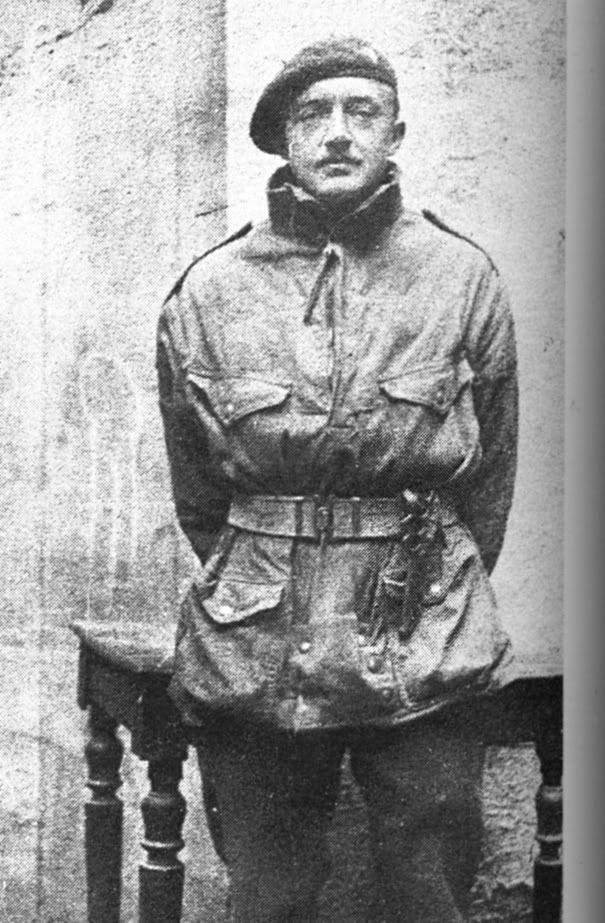What with Steve Jobs pissing in my Grape Nuts and my taking potshots at self-styled mythical beings...
 Harking back, with that title to the passage that led off the last post, taken from from Lyn MacDonald's excellent history of the Somme offensive.
Harking back, with that title to the passage that led off the last post, taken from from Lyn MacDonald's excellent history of the Somme offensive.I've touched on the trench knife phenomenon before but, other than in passing, I've never dealt deeply with the one knife that seems to represent the essence of the knuckle-knife.
I call it the Clements' Knuckle Knife on my website but that's just for convenience sake.
Charles Clements was a cutlery retailer, based in London .
As such, He'd contract with any number of manufacturers and market their wares.
Consequently, a number of knives could be legitimately called "Clements' knives".
See below:


That being said, what I call the Clements' knife is one of many variations on the upside-down-bladed "throat cutter" pictured at top.
The knife pictured is a WW2 vintage knockoff known as the BC ("British Commando"?)41.
Also the photo illustrates the apparently preferred, Brit manner of using these knives; that is to say, utilizing the "ice-pick" grip.
This grip is common on British trench knives. Often, when there finger-loops incorporated into the hilt, they graduate in size smallest to largest from the blade back. See left hand example.
The pommel, finger loop is clearly larger than the one nearest the blade.
I can't recall where I read this but, the idea behind this design was said to be; that one would smack someone in the jaw with the knucks; then the follow-through would rip out his (or her) throat.
A very ugly level of devising to be devising at, methinks.
In any case, it was level leaded, linear thinking, clear-eyed, rational beings who came up with this thing.
It does seem as if it would be effective.
During the First War the hilts used on the majority of these knives were made of aluminum (the "wonder metal" of the day).
In the "modren world" of today we often lose sight of how recent some innovations actually are.
Aluminum, the second-most abundant element in the earth's crust, is obviously a metal, yet it exists nowhere in nature in a metallic state.
This isn't a huge deal since even iron is never found as a metal, other than in meteorites.
It's just that aluminum (like its modern counterpart, titanium) is extracted by a rather more involved process than simply melting it from broken rocks.
In fact, Germany, at the time probably the most technologically advanced nation on earth, didn't even have an aluminum smelting industry until 1914.
So, a space-age material, a need to mount pointy things in some relationship to the human hand, an abiding affection for knuckledusters (And why not? They're they're cutest things!), what could have come out of this but the "Clements'/Rodgers/Beardshaw/Hibbert & Sons/George Ibberson and others...whew, knife".

Generally speaking a Clement's is, according to the rather dismissive description given by Michael Silvey in an article from "Knife World", produced "...by the expedient process of riveting a blade to a set of... knuckles."
Colored photo above: My version of a generic, Great War, aluminum-handled Clement's and my reproduction of a brass-handled BC 41.
The BC 41 was developed in 1941, presumably for the use of the British Commandos. At least that's what everyone assumes what the "BC" stands for, but no one is sure.
They were made with either a grip of cast iron or brass and were used by the British prior to the onset of their national F/S mania.
 According to the photo to the left, they were used well into the Fairbairn-Sykes period by some.
According to the photo to the left, they were used well into the Fairbairn-Sykes period by some.We see Private Gilbody of the 2nd Parachute Brigade, circa 1943.
Additionally one can see, if one looks closely, that someone, the good private, or persons unknown, has broken out the top finger loop.
This rather common bit of damage is attributed to a desire to carry the knife while firing a rifle.
See next photo. I doubt the authenticity of this pic. It seems too perfect and crisp and recent. It does illustrate the concept, albeit a slightly different approach.
Buy it here.

Right now I'll say:
$135 delivered, sheath included.
Coming soon:
BC41 knuckleduster.
Below, a theater-produced variation. I'm guessing a sword or bayonet-tip screwed to a grip cut from an aluminum extrusion.
Oh yeah...











5 comments:
I might have misunderstood, but are you selling vintage knuckle knives or your own reproductions of them? I might be interested.
Now there's a teaser...
They're my own reproductions.
I could never afford originals so I started making knives that I liked.
One thing led to another...
There's a link to my site in the upper left margin, near the crossed monkey-wrenches.
nike huarache
yeezy 500
yeezy
golden goose sneakers
moncler jackets
off white nike
cheap jordans
calvin klein underwear
golden goose sneakers
supreme
I just couldn't have loved you more.Then you posted this picture of me dropping my chin on the floor.
토토사이트링크
토토사이트웹
우리카지노탑
바카라사이트
diingzuui092
golden goose outlet
golden goose outlet
golden goose outlet
supreme outlet
golden goose outlet
golden goose outlet
golden goose outlet
golden goose outlet
golden goose outlet
golden goose outlet
Post a Comment